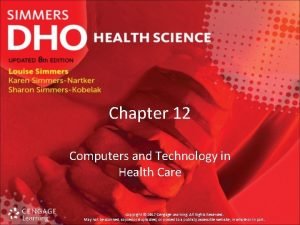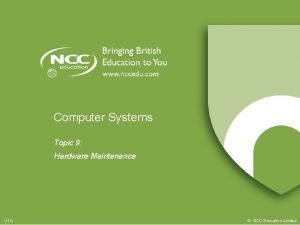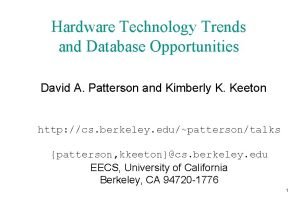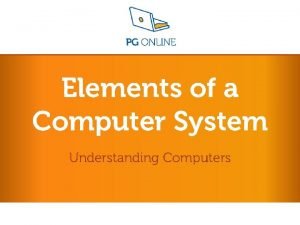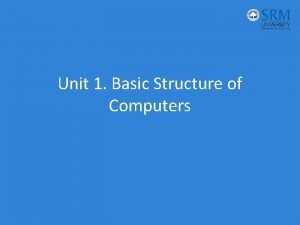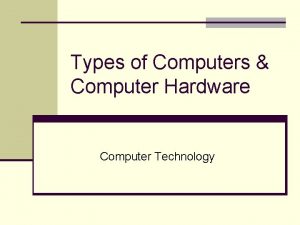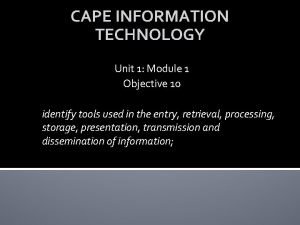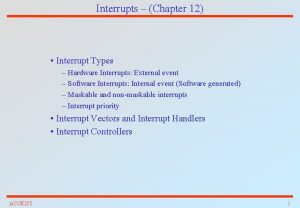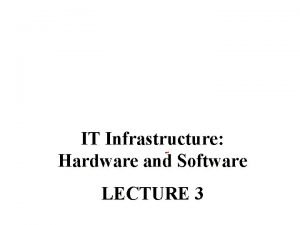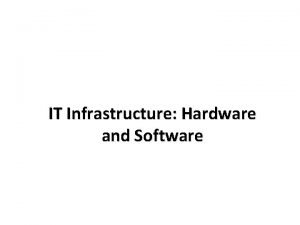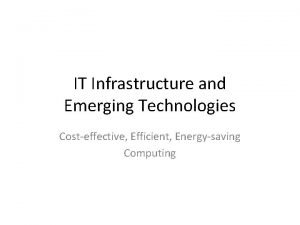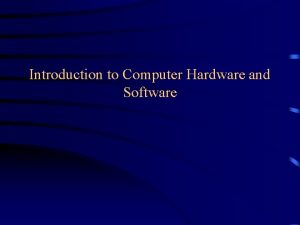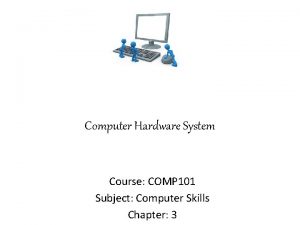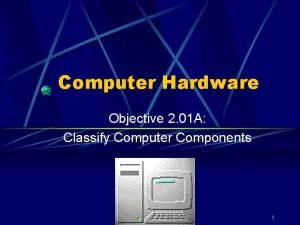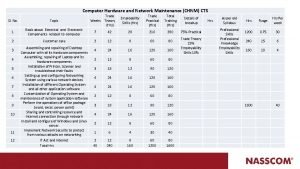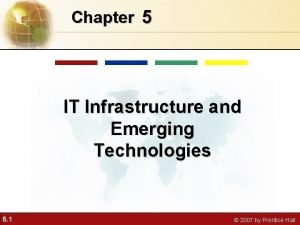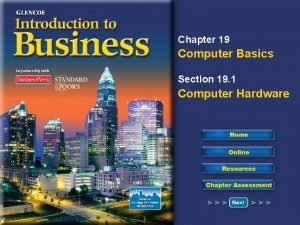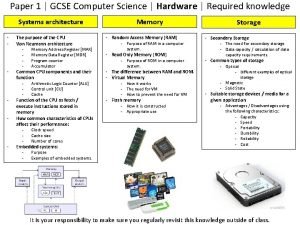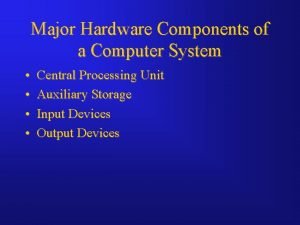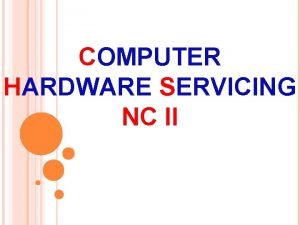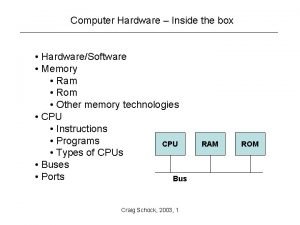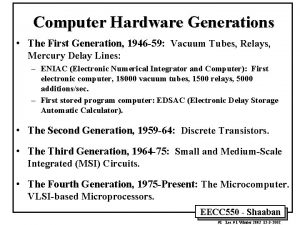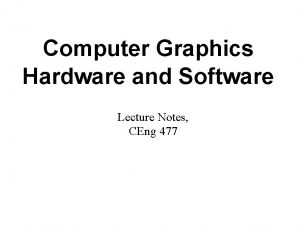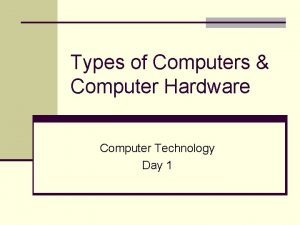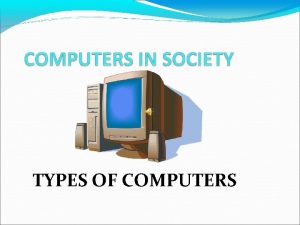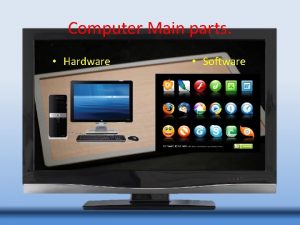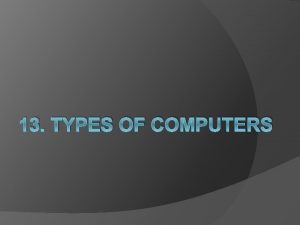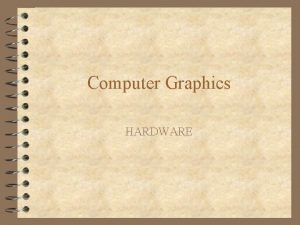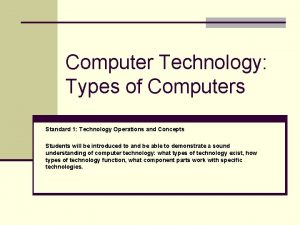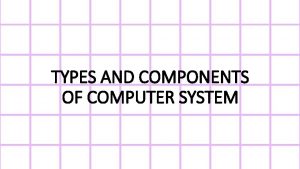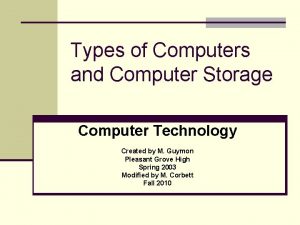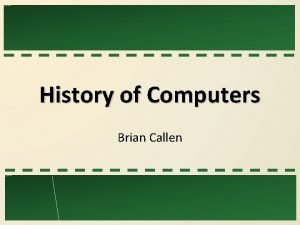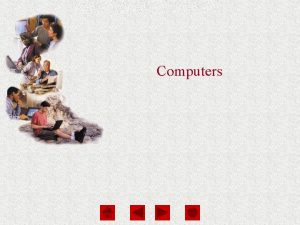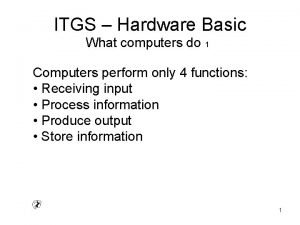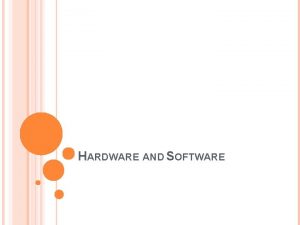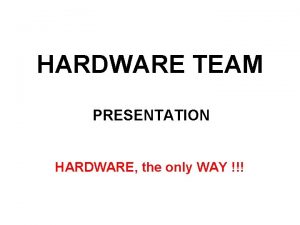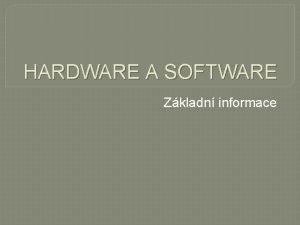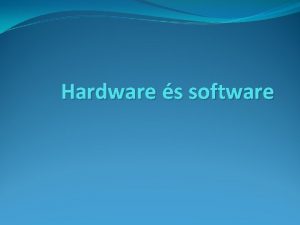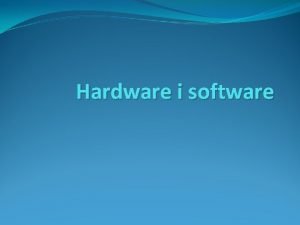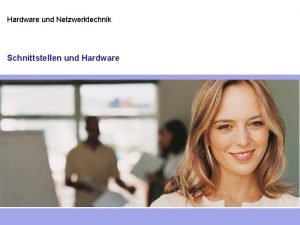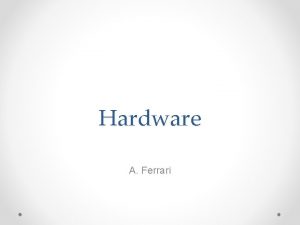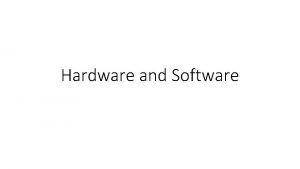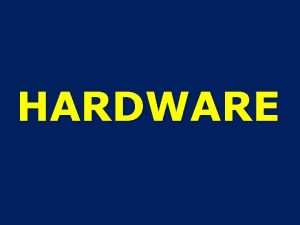Types of Computers Computer Hardware Computer Technology Notes




























- Slides: 28

Types of Computers & Computer Hardware Computer Technology – Notes #1

Basic Terminology Computer o A device that accepts input, processes data, stores data, and produces output, all according to a series of stored instructions. Hardware o Includes the physical electronic and mechanical devices that process the data; refers to the computer as well as peripheral devices. • Peripheral devices are those separate from the computer, such as a printer • Hardware is something that we can see, touch, and move around

Basic Terminology Software o A computer program that tells the computer how to perform particular tasks. Network o Two or more computers and other devices that are connected, for the purpose of sharing data and programs. Peripheral devices o Used to expand the computer’s input, output and storage capabilities o Examples: Printer, keyboard, mouse

Cycle (Input, Processing, Output, Storage) Input o Whatever is put into a computer system. Data o Refers to the symbols that represent facts, objects, or ideas. Information o Raw data is converted into something we can understand use: information Output o Seeing or printing the results of the processing by the computer

Basic Terminology Processing o Converting raw data into information Memory o Area of the computer that temporarily holds data waiting to be processed, stored, or output. It is also known as Random Access Memory, or RAM Storage o Area of the computer that holds data on a permanent basis when it is not immediately needed for processing. o This could be software programs or documents

Types of Computers

Desktop Microcomputer A microcomputer that fits on a desk and runs on power from an electrical wall outlet. The processing components can be housed in either a vertical or a horizontal case. May have separate components (keyboard, mouse, etc. ) that are each plugged into the computer.

Laptop Computer A portable, compact computer that can run on an electrical wall outlet or a battery unit. All components (keyboard, mouse, etc. ) are in one compact unit. Usually more expensive than a comparable desktop. Sometimes called a Notebook.

Workstation Powerful desktop computer designed for specialized tasks. Can tackle tasks that require a lot of processing speed. Can also be used to describe an ordinary personal computer attached to a LAN (local area network).

Supercomputer A computer that was the fastest in the world at the time it was constructed, containing thousands of processors Can tackle tasks that would not be practical for other computers. o Typical uses • Quantum physics • Weather system modeling & prediction • Complex simulations

Mainframe Large expensive computer capable of simultaneously processing data for hundreds or thousands of users. Used to store, manage, and process large amounts of data that need to be reliable, secure, and centralized. Usually housed in a closet sized cabinet.

Server Purpose is to “serve. ” A computer that has the purpose of supplying its users with data; usually through the use of a LAN (local area network). A server might control hundreds or thousands of computers IBM Server Commercial

Smartphone A handheld computer integrated within a mobile telephone. Access to the Internet Allows the user to install and run applications. Can be synchronized with a personal microcomputer as a backup.

Tablet Computer A tablet computer is a one-piece, mobile version of a personal computer, including Internet access o Primarily operated by touchscreen (the user's finger essentially functions as the mouse and cursor o May be connected to a keyboard o Printing may be accomplished wirelessly

Computer Hardware – The Physical Devices of the Computer

System unit Case that holds the power supply, storage devices, and the circuit boards (including the motherboard). May be in a vertical or horizontal format

CPU (Central Processing Unit) Where the processing in a computer takes place, often called the “brain” of the computer.

Input Devices Units that gather data and transform that data into a series of electronic signals for the computer to process.

Input Device: Keyboard An arrangement of letters, numbers, and special function keys that act as the primary input device to the computer.

Input Device: Mouse An input device that allows the user to manipulate objects on the screen by moving the device along the surface of a desk.

Input Device: Sound Card (Microphone) A circuit board that gives the computer the ability to accept audio input, play sound files, and produce audio output through speakers or headphones.

Output Devices that display, print, or transmit the results of processing from the computer’s memory.

Output Device: Monitor Display device that forms an image by converting electrical signals from the computer into points of colored light on the screen. o Resolution • The density of the grid used to display or print text and graphics; the greater the horizontal and vertical density, the higher the resolution. o Pixels • The smallest unit in a graphic image; computer display devices use a matrix of pixels to display text and graphics.

Output Device: Printer Output device that produces text or graphical images on paper (hard copy) Many types available

Output Device: Sound Car (Speakers) Output devices that receive signals from the computer’s sound card to play music, narration, or sound effects.

Storage Devices Unlike memory, which is temporary, storage devices are used to keep data when the power to the computer is turned off. Different forms o Internal hard drive (most important storage device) o Thumb drive or flash drive (take your data with you) o External hard drive (take it with you or backup all your data) o SD cards (for use in mobile devices, cameras, etc)

Other Storage – Cloud Storage Cloud storage is placing your documents on a site on the Internet which can be accessed from any computer o Examples: Dropbox, Skydrive, Google Drive

Resource Google Images
 External hardware components
External hardware components Chapter 12 computer and technology in health care
Chapter 12 computer and technology in health care Hardware topic
Hardware topic Hardware technology trends
Hardware technology trends Elements of computer
Elements of computer Basic structure of computer
Basic structure of computer Types of computer technology
Types of computer technology Facteur g
Facteur g Term 4 natural science grade 7
Term 4 natural science grade 7 Cape information technology unit 1 notes
Cape information technology unit 1 notes Natural science grade 7 term 2 practical tasks
Natural science grade 7 term 2 practical tasks Natural science grade 7 term 3 notes
Natural science grade 7 term 3 notes Types of interrupts
Types of interrupts Computer hardware platforms in it infrastructure
Computer hardware platforms in it infrastructure Software and its types
Software and its types Computer hardware platforms in it infrastructure
Computer hardware platforms in it infrastructure Introduction of computer hardware
Introduction of computer hardware Fftooo
Fftooo Computer hardware 101
Computer hardware 101 Computer hardware classification
Computer hardware classification Computer hardware & network maintenance
Computer hardware & network maintenance Chapter 5 it infrastructure and emerging technologies
Chapter 5 it infrastructure and emerging technologies Graphic organizer of computer hardware
Graphic organizer of computer hardware Hardware gcse computer science
Hardware gcse computer science Parts of computer
Parts of computer Computer hardware servicing nc2
Computer hardware servicing nc2 Computer hardware
Computer hardware Generation hardware
Generation hardware Hardware and software in computer graphics
Hardware and software in computer graphics

